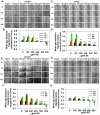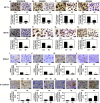Sensitization of Carboplatinum- and Taxol-Resistant High-Grade Serous Ovarian Cancer Cells Carrying p53, BRCA1/2 Mutations by Emblica officinalis (Amla) via Multiple Targets
- PMID: 32194804
- PMCID: PMC7052860
- DOI: 10.7150/jca.36919
Sensitization of Carboplatinum- and Taxol-Resistant High-Grade Serous Ovarian Cancer Cells Carrying p53, BRCA1/2 Mutations by Emblica officinalis (Amla) via Multiple Targets
Abstract
Background: Ovarian cancer (OC), the most lethal gynecologic malignancy, is highly resistant to current treatment strategies. High-grade serous epithelial ovarian cancer (HGSOC) cells with increased somatic mutations and genomic instability and the resulting heterogeneous mutant phenotypes are highly resistant to therapy. Plant-derived natural products, including Amla (Emblica officinalis) extract (AE), have demonstrated potent anti-neoplastic properties. Recently we demonstrated that AE inhibits cell growth and the expression of angiogenic factors in OVCAR3 and SKOV3 OC cells in vitro as well as in xenografts in vivo. The goal of this study was to determine the anti-proliferative, anti-angiogenic and anti-metastatic effects of AE on carboplatinum- and taxol-resistant HGSOC cells carrying p53, BRCA1/2 mutations. Methods: Anti-proliferative and anti-metastatic effects of AE on recently characterized carboplatinum- and taxol-resistant HGSOC cells (TOV3041G, OV866(2), OV4453 and, OV4485) was determined using the MTT, migration, invasion and spheroid assays in vitro. To understand the mechanism of AE-induced changes in angiogenesis-related hypoxia-inducible factor 1α (HIF-1α) and insulin growth factor receptor 1 (IGF1R), and EMT-associated SNAIL1 and E-cadherin proteins were studied using immunostaining and Western blotting. In vivo effects of AE were determined using mouse xenograft tumor model of OC developed by subcutaneous injection of OV4485 cells that carry mutant p53 and BRCA1, most aggressive and resistant among HGSOC cell lines used in this study. Tumor growth was measured using morphometry. Immunostaining and Western blotting were used to determine changes in Ki67 (proliferation marker), CD31 (angiogenesis marker) as well as changes in HIF-1α, IGF1R, SNAIL1 and E-cadherin proteins. Results: AE significantly attenuated migration and invasiveness properties of all tested HGSOC cell phenotypes (P≤0.001), significantly reduced the expression of HIF-1α, IGF1R, and SNAIL1 and increased the expression of E-cadherin in all tested HGSOC cell lines (P=<0.05). Oral administration of AE for 4 weeks caused a significant regression of mouse xenograft tumor (>60%) that derived from OV4855 cells and decreased the expression of endothelial cell antigen-CD31, HIF-1α, IGF1R and SNAIL1 and increased the expression of E-cadherin in tumor tissues. Conclusions: AE sensitizes platinum- and taxol-resistant heterogenous HGSOC cells carrying mutations in p53, BRCA1/2 genes, and attenuates their malignant characteristics through targeting key signaling mechanisms of angiogenesis and metastasis. AE is a potential adjunct therapeutic agent for treating resistant, mutant, heterogenous OC.
Keywords: Amla; angiogenesis; high-grade serous ovarian cancer; metastasis; mutation; resistant; sensitize.
© The author(s).
Conflict of interest statement
Competing Interests: The authors have declared that no competing interest exists.
Figures





Similar articles
-
Emblica officinalis extract downregulates pro-angiogenic molecules via upregulation of cellular and exosomal miR-375 in human ovarian cancer cells.Oncotarget. 2016 May 24;7(21):31484-500. doi: 10.18632/oncotarget.8966. Oncotarget. 2016. PMID: 27129171 Free PMC article.
-
Emblica officinalis extract induces autophagy and inhibits human ovarian cancer cell proliferation, angiogenesis, growth of mouse xenograft tumors.PLoS One. 2013 Aug 15;8(8):e72748. doi: 10.1371/journal.pone.0072748. eCollection 2013. PLoS One. 2013. PMID: 24133573 Free PMC article.
-
Rescue of p53 functions by in vitro-transcribed mRNA impedes the growth of high-grade serous ovarian cancer.Cancer Commun (Lond). 2024 Jan;44(1):101-126. doi: 10.1002/cac2.12511. Epub 2023 Dec 22. Cancer Commun (Lond). 2024. PMID: 38140698 Free PMC article.
-
Studying platinum sensitivity and resistance in high-grade serous ovarian cancer: Different models for different questions.Drug Resist Updat. 2016 Jan;24:55-69. doi: 10.1016/j.drup.2015.11.005. Epub 2015 Nov 26. Drug Resist Updat. 2016. PMID: 26830315 Review.
-
Targeting the Microenvironment in High Grade Serous Ovarian Cancer.Cancers (Basel). 2018 Aug 10;10(8):266. doi: 10.3390/cancers10080266. Cancers (Basel). 2018. PMID: 30103384 Free PMC article. Review.
Cited by
-
Molecular Mechanisms of Cancer Prevention by Gooseberry (Phyllanthus emblica).Nutr Cancer. 2022;74(7):2291-2302. doi: 10.1080/01635581.2021.2008988. Epub 2021 Nov 28. Nutr Cancer. 2022. PMID: 34839775 Free PMC article. Review.
-
Investigations of cellular copper metabolism in ovarian cancer cells using a ratiometric fluorescent copper dye.J Biol Inorg Chem. 2023 Feb;28(1):43-55. doi: 10.1007/s00775-022-01978-9. Epub 2022 Dec 5. J Biol Inorg Chem. 2023. PMID: 36469143
-
MicroRNA‑193a‑5p exerts a tumor suppressive role in epithelial ovarian cancer by modulating RBBP6.Mol Med Rep. 2021 Aug;24(2):582. doi: 10.3892/mmr.2021.12221. Epub 2021 Jun 16. Mol Med Rep. 2021. PMID: 34132380 Free PMC article.
-
Current advances on the phytochemical composition, pharmacologic effects, toxicology, and product development of Phyllanthi Fructus.Front Pharmacol. 2022 Oct 19;13:1017268. doi: 10.3389/fphar.2022.1017268. eCollection 2022. Front Pharmacol. 2022. PMID: 36339628 Free PMC article. Review.
References
-
- Horiuchi A, Hayashi T, Kikuchi N, Hayashi A, Fuseya C, Shiozawa T. et al. Hypoxia upregulates ovarian cancer invasiveness via the binding of HIF-1alpha to a hypoxia-induced, methylation-free hypoxia response element of S100A4 gene. International journal of cancer. 2012;131:1755–67. - PubMed
Grants and funding
LinkOut - more resources
Full Text Sources
Research Materials
Miscellaneous

